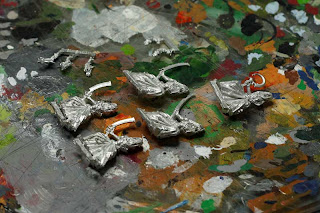I've been working with a lot of plastic (and a little bit of resin) lately, so as a change of pace I decided to build and paint a box of Dark Eldar Mandrakes I've been sitting on for a while. Here's a step-by-step of my process for getting these models on the table.
First, gather some tools. For metal models you'll need a file and hobby knife (this one here has a broken tip; I use to to clean plastic and metal models). I've got the pinning drill and rod out as well, because those Mandrake arms look pretty skinny.
And here's the lot of them. The first thing I do is inspect all the models checking to make sure that I have all the parts and that nothing is broken right off the bat. I did have to straighten out a few swords, but nothing major. After using metal clippers (not your plastic sprue clippers!) to clean off the excess tabs and cut the arms off the metal sprue, we're read to get started cleaning the mold lines and excess bits common to metal models.
Be gentle with the file: let the tool do the work, not the force from your arm and shoulder. Also be sure to nip the little extrusion bits you'll find at the bottom edges of robes and in places like elbows, fingers and either end of the sword. Here's a picture of a few of the nibs; I cut the off with the hobby knife if they are long, shorter ones get filed down. I also file down the slotted tab a little so it fits better in the plastic base and doesn't sit too high.
Once you've got all the models cleaned up, check to see which arms fit with which bodies. There are three styles of arm and body for the Mandrakes and after fiddling a little, each arm really only fits on the appropriate body. Make sure you have cleaned the arm socket joint to get a good seal when you glue them together. Unfortunately the arm connects to the sprue right at the joint, so you have to do some work here to get a clean fit.
The socket looked pretty strong once cleaned up, so I didn't pin the arms. After gluing I tested the strength and only one popped off. I reglued it and it was stonger. If I'd popped off two arms, I probably would have pinned the lot of them, but I think they'll be ok.
I set them in their slotta bases to dry overnight. Now to work on the bases. Since the Mandrakes are barefoot and their feet are pretty small, I wanted to make sure I'd have them standing on the basing material and not in it so I put the basing sand mix down before I put the model in the slotta base.
For Space Marines or models with larger feet and boots, I just glue the model to the base and then use the toothpick to place the sand on the base around the feet.
Use a toothpick to evenly spread the white/PVA glue across the whole base.
And then give it a dunk in the sand mix. The sand mix here is my small-sand mix: fine masonry sand, sandbox sand and some small ballast.
Make sure to let the sand dry completely before putting the models on the base or they may sink into the wet sandy glue. After the model goes in the slotta base and is dried, you'll have to touch up the slotta tab with glue and sand.
A quick dip in the sand and shake off the excess and he's ready for priming.
Here's the squad before priming.
And mounted up to priming sticks:
Sometimes when you prime you'll notice a mold line you missed. Just grab the file and clean it off.
That's better. For table-quality minis, I usually just leave mold lines I find after priming when I'm back at the painting table. For a really nice paint job, I'd select a model that doesn't have a lot of mold lines in the first place, so sometimes I think that the table quality pieces get the most cleaning and prep.
Stay tuned for painting the Mandrakes in Part 2.















